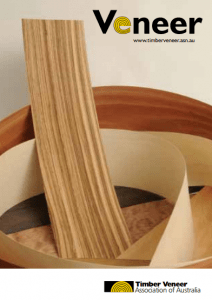Cleaning and general care
The ongoing, in service, care of finished veneered surfaces depends largely on the type and quality of coating utilised. Thus, the manufacturer of the finish should be involved in preparing the recommended care instructions for the furniture, joinery or fit-out.
This can occur at the specification stage or by the chosen joiner/cabinetmaker as they are the people in control of the final product and finish.
In general, timber veneered surfaces should not be left wet/damp or with wet staining materials on them (such as dark fruit juice/wine). They should not be cleaned with harsh cleaners or chemicals that affect the surface finish. Abrasive cleaning of clear finishes can scratch the surface and reduce the visual clarity. Sharp edges are potential problem zones for breaks or cracks in the coating as during the finishing process the coating tends to flow away from sharp edges resulting in a thinner coating in that region. Therefore, it is recommended such edges be eliminated by design, or by sanding during manufacture.
Veneered products are not suitable for high wear and wet horizontal surfaces such as kitchen counter tops, unless the veneer is completely encased within a suitable resin system. Veneer surfaces (like all coloured materials) will always change colour, to a greater or lesser degree, particularly upon exposure to natural and artificial light. The degree of colour change will depend on such factors as the species chosen, the coating type used and the intensity and period of time of exposure to light. Some stains, notably dye stains, can fade if subjected to long term ultra violet light. In addition, conventional coatings have a tendency to yellow with age which can have quite a dramatic effect on the original colour of the stain/timber veneer selected. To minimise this, low-yellowing finishes can be specified.
It is not possible to comprehensively speak on behalf of all coatings, board and glue suppliers, nor on how these products is used or applied. These factors and their interactive effects are beyond our control. We believe the best source of in service care information is the coating manufacturers; however, following are some specific care and cleaning instructions.
Specific Cleaning and Care Instructions for Coated Veneered Surfaces
Dusting: Use only a soft dry cloth or feather duster.
Polishing: Use a high quality furniture polish and a soft dry cloth. It i srecommended the polish used not contain any silicone as they may cause recoating or refurbishment problems at a later date. Abrasive polishes should be avoided.
Extreme Temperature Changes: The expansion or contraction of the timber due to extreme temperature changes may cause damage to the surface coating. Care should be taken in air conditioned or heated environments to keep temperature changes within reasonable limits. Use heat resistant place mats under hot food and beverages to avoid heat damage.
Spillages: All spillages should be cleaned with a damp cloth as soon as possible. Moisture may cause damage to the coating. High humidity, steam and excessive water being in contact with the coating may cause the coating to crack, or if it gets under the coating cause white marking of the veneer surface. If spilled, all chemical substances and alcohol should be removed immediately from all veneered surfaces.
Dirty or Greasy Marks: After first wiping with a dry cloth, wipe with a cloth lightly dampened with a mixture of water and a high quality furniture polish. Persistent dirty or greasy marks may be removed by mild, non-abrasive proprietary cleaners appropriate to the type of surface finish. The appropriateness of the cleaner should be sought from the surface coating or cleaner manufacturer. The effect of the cleaner on the surface should be tested on a hidden or a less conspicuous section on the finished veneer surface.
Direct Sunlight: Direct sunlight should be avoided on all internal veneered surfaces as fading, bleaching or colour changes of the surface coating and of the veneer may occur. Excessive not sunshine may dry the veneer surface more quickly than the veneer substrate thereby causing small surface checks parallel to the grain to appear and possibly damage the surface coating.
Disclaimer: The information, opinions, advice and recommendations contained in this Technical Bulletin have been prepared with due care. They are offered only for the purpose of providing some useful and helpful assistance to specifiers and their clients. Whilst every effort has been made to ensure that this is in accordance with current technology, it is not intended as an exhaustive statement of all relevant knowledge. As the interactive effects of the whole range of substrates, glues, veneers, surface finishes and the final end uses of the products are outside our control, the Timber Veneer Association of Australia accepts no responsibility for error in, or omissions from, this information, nor for specifications or work done or omitted to be done in reliance on this Bulletin.

